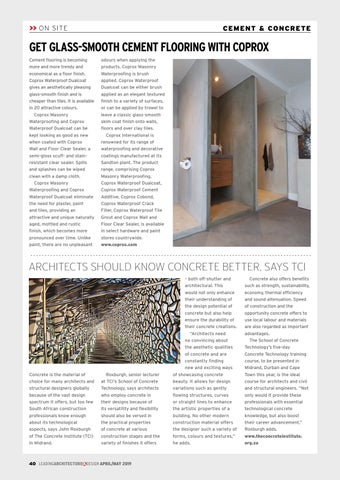>> O N SITE
CE M E NT & CO N CRETE
GET GLASS-SMOOTH CEMENT FLOORING WITH COPROX Cement flooring is becoming more and more trendy and economical as a floor finish. Coprox Waterproof Dualcoat gives an aesthetically pleasing glass-smooth finish and is cheaper than tiles. It is available in 20 attractive colours. Coprox Masonry Waterproofing and Coprox Waterproof Dualcoat can be kept looking as good as new when coated with Coprox Wall and Floor Clear Sealer, a semi-gloss scuff- and stainresistant clear sealer. Spills and splashes can be wiped clean with a damp cloth. Coprox Masonry Waterproofing and Coprox Waterproof Dualcoat eliminate the need for plaster, paint and tiles, providing an attractive and unique naturally aged, mottled and rustic finish, which becomes more pronounced over time. Unlike paint, there are no unpleasant
odours when applying the products. Coprox Masonry Waterproofing is brush applied. Coprox Waterproof Dualcoat can be either brush applied as an elegant textured finish to a variety of surfaces, or can be applied by trowel to leave a classic glass-smooth skim coat finish onto walls, floors and over clay tiles. Coprox International is renowned for its range of waterproofing and decorative coatings manufactured at its Sandton plant. The product range, comprising Coprox Masonry Waterproofing, Coprox Waterproof Dualcoat, Coprox Waterproof Cement Additive, Coprox Cobond, Coprox Waterproof Crack Filler, Coprox Waterproof Tile Grout and Coprox Wall and Floor Clear Sealer, is available in select hardware and paint stores countrywide. www.coprox.com
ARCHITECTS SHOULD KNOW CONCRETE BETTER, SAYS TCI
Concrete is the material of choice for many architects and structural designers globally because of the vast design spectrum it offers, but too few South African construction professionals know enough
Roxburgh, senior lecturer at TCI’s School of Concrete Technology, says architects who employ concrete in their designs because of its versatility and flexibility should also be versed in
– both off-shutter and architectural. This would not only enhance their understanding of the design potential of concrete but also help ensure the durability of their concrete creations. “Architects need no convincing about the aesthetic qualities of concrete and are constantly finding new and exciting ways of showcasing concrete beauty. It allows for design variations such as gently flowing structures, curves or straight lines to enhance the artistic properties of a building. No other modern
about its technological aspects, says John Roxburgh of The Concrete Institute (TCI) in Midrand.
the practical properties of concrete at various construction stages and the variety of finishes it offers
construction material offers the designer such a variety of forms, colours and textures,” he adds.
40 LEADINGARCHITECTURE & DESIGN APRIL/MAY 2019
Concrete also offers benefits such as strength, sustainability, economy, thermal efficiency and sound attenuation. Speed of construction and the opportunity concrete offers to use local labour and materials are also regarded as important advantages. The School of Concrete Technology’s five-day Concrete Technology training course, to be presented in Midrand, Durban and Cape Town this year, is the ideal course for architects and civil and structural engineers. “Not only would it provide these professionals with essential technological concrete knowledge, but also boost their career advancement,” Roxburgh adds. www.theconcreteinstitute. org.za







